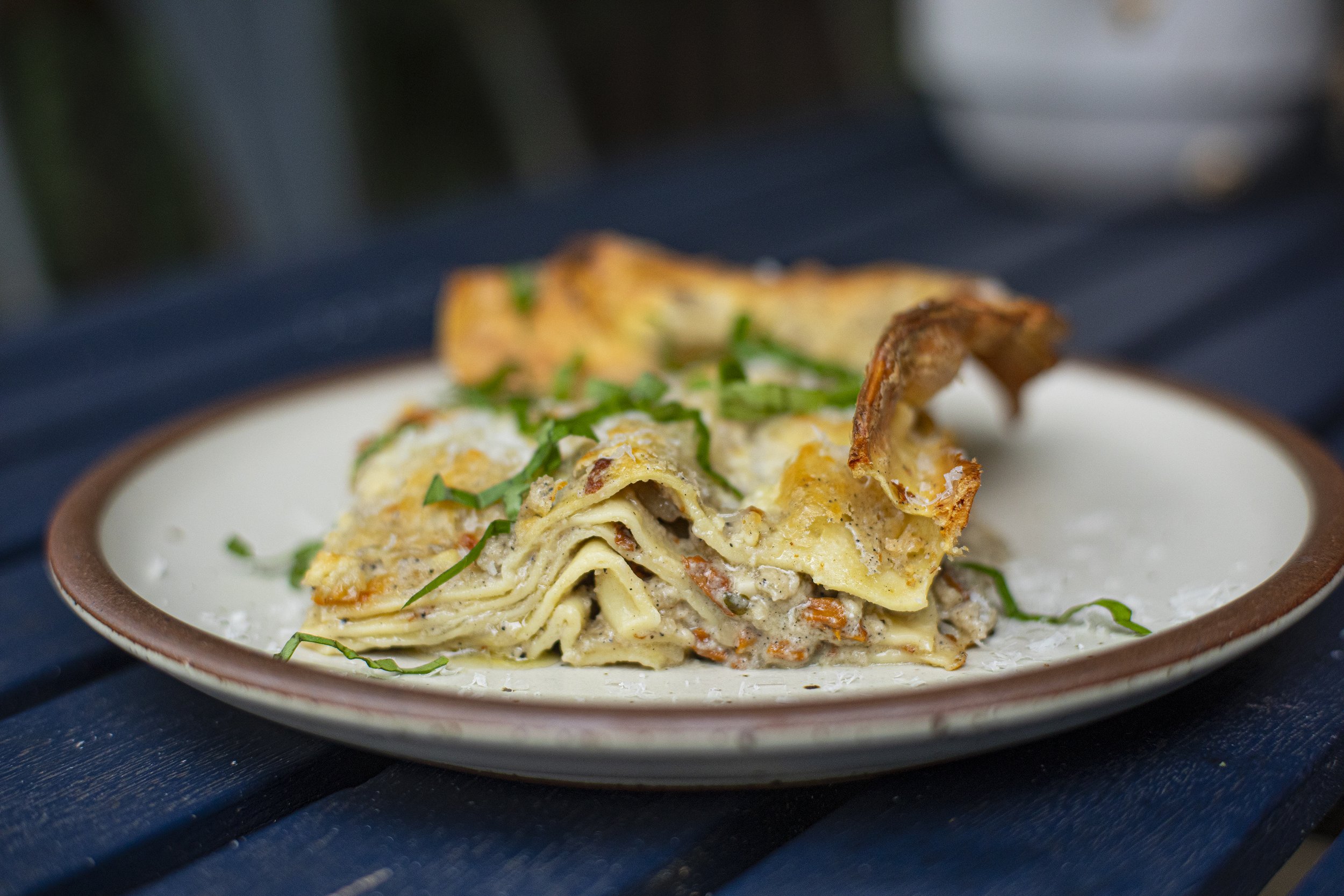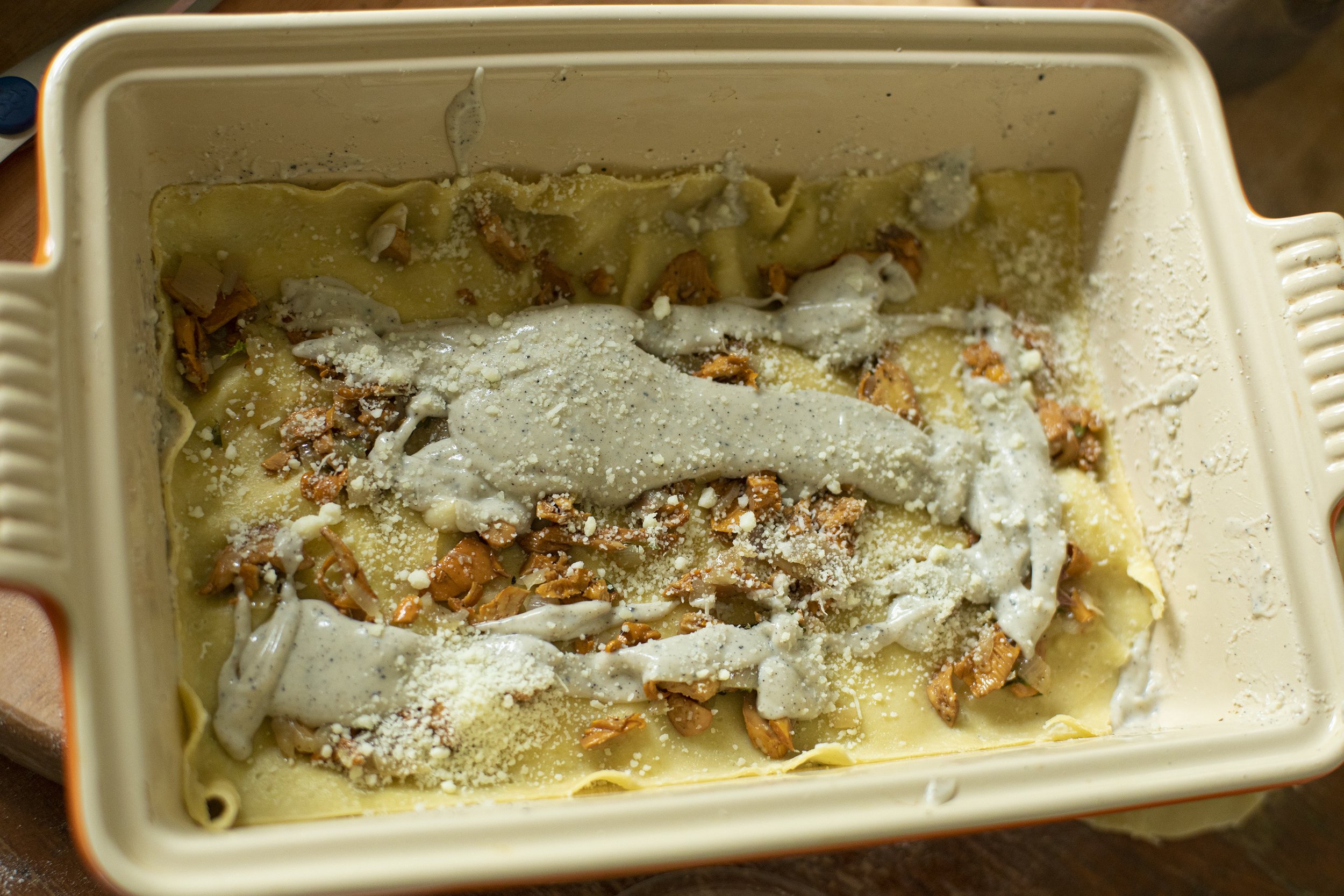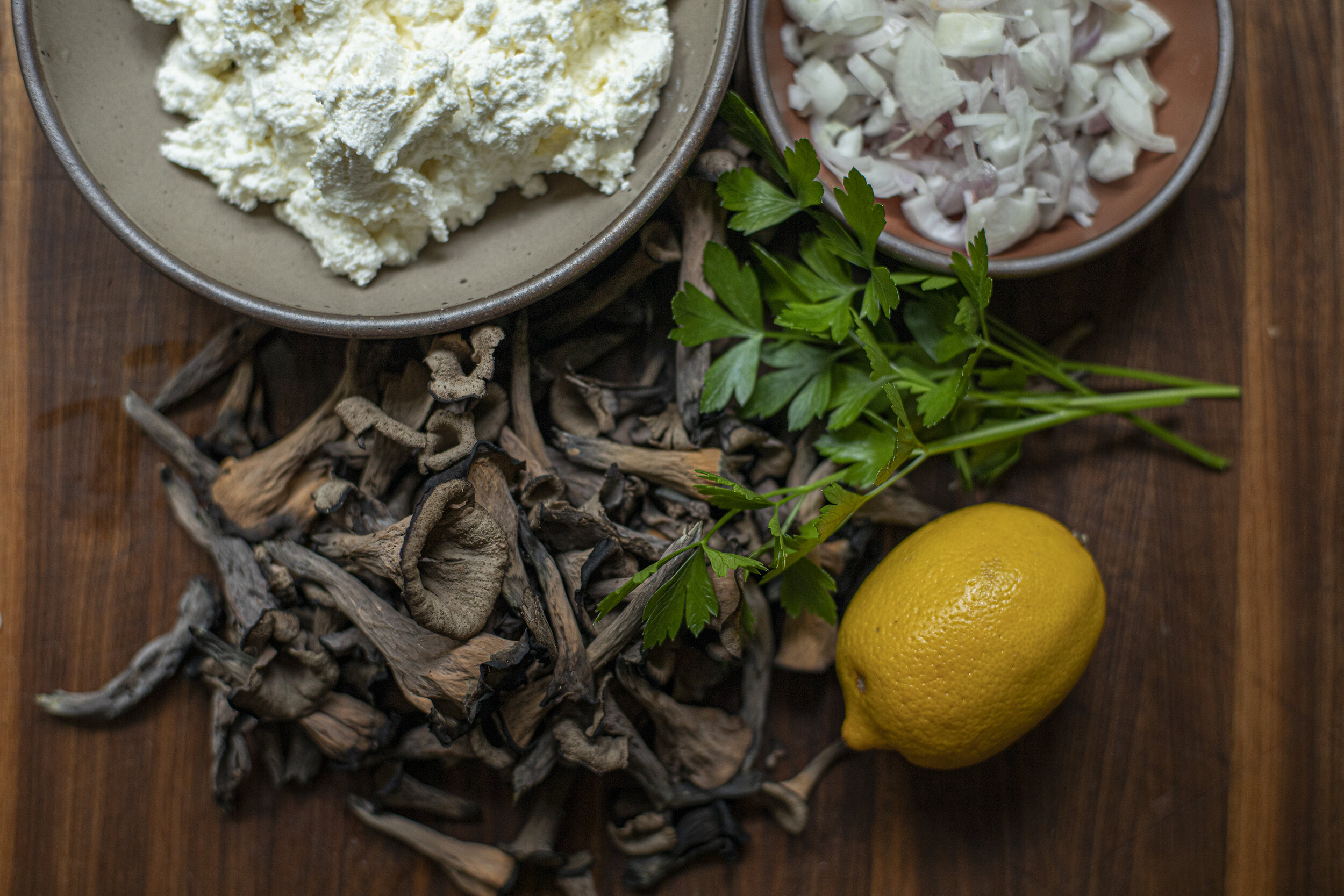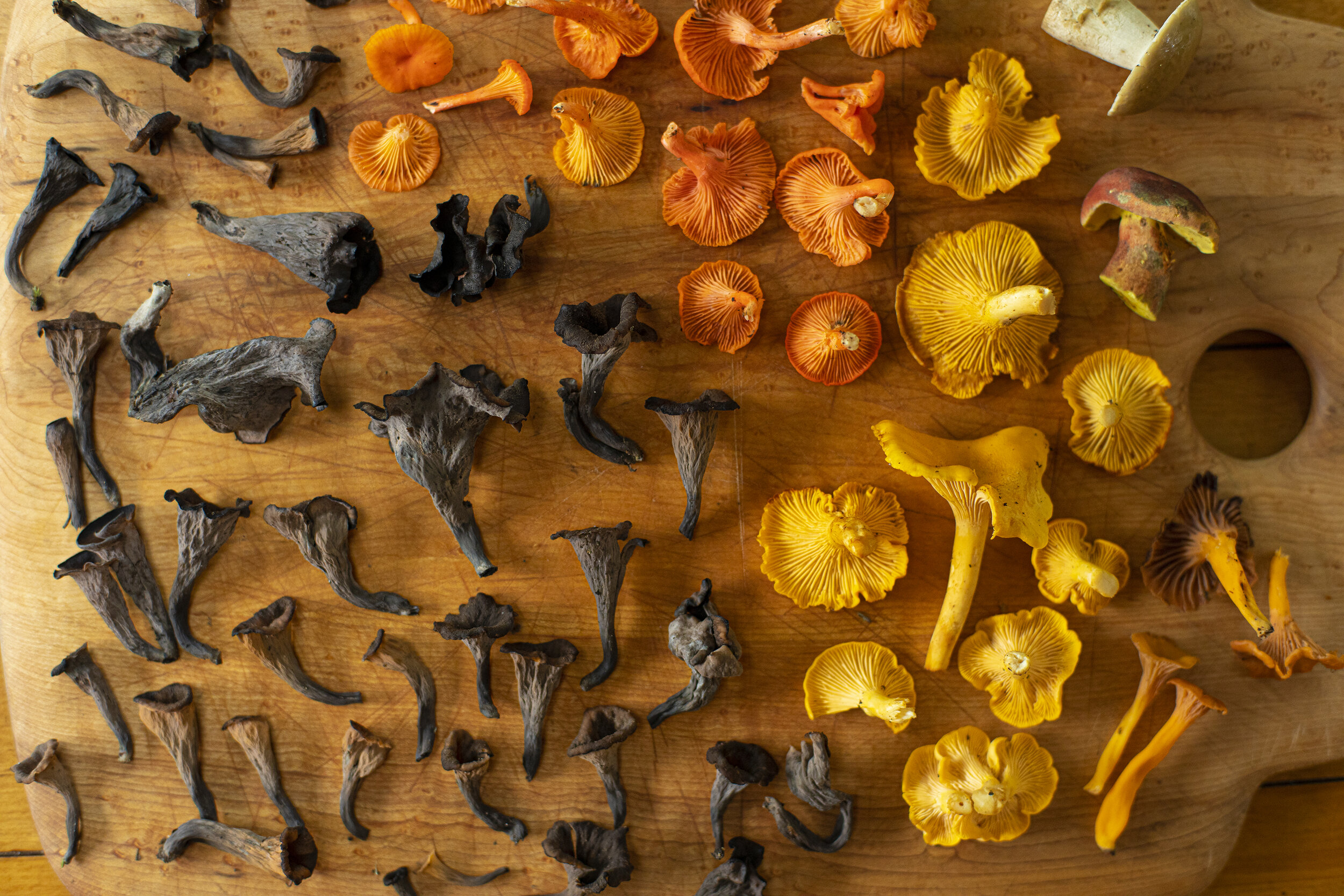Wild Mushroom Lasagna with Black Trumpet Bescamel
A wild summer mushroom lasagna with a black trumpet bechamel. The foundation of the recipe was heavily inspired by Evan Funke ‘s American Sfoglino which is a great book for anyone obsessed with pasta. This was decadent yet subtle - nothing beats a big fat corner of lasagna with crispy edges. Full recipe below along with a detailed video of the process.
The Pasta
Ingredients
454 g 00 Flour
258 g eggs (beaten before mixing)
*makes roughly 5 layers of 9 x 13 inch pasta. Four of those layers can be cut exactly to the size of your pan, and with the scraps you can assemble the 5th layer.
Directions
Mix the flours and dump out the weighed amount onto a clean work surface.
Use your hand to form a well (like a volcano) in the center of the flour.
Carefully pour your eggs into the center and begin slowly mixing together with a fork. Gradually, carefully, work your way all around to incorporate the eggs with the flour, without breaking the outer wall. A bench scraper is a handy tool to have at this point if you have one.
After about 5 - 10 minutes it will start coming together into a shaggy mass. Begin using your hands to knead the dough together. Work diligently for another 5 minutes until it is no longer shaggy.
Use the edges of your hands, knuckles, to work the dough until it starts to form a smooth ball. Knead it, applying pressure, into the work surface. Fold it. Knead it again. After about ten minutes it should be smooth and ready to rest.
Cut the dough into two and wrap each in plastic wrap. Set into the fridge for at least 30 minutes.
The following steps revolve around using a mattarello (Italian rolling pin) - but you could also do this with a pasta machine. Remove one of the dough balls, unwrap, cut it in half (resulting in 1/4 the amount of the original dough ball. Wrap the other half while you roll your first sheet. Place the cut piece of pasta dough in the center of your work surface. Apply a light dusting of flour to both the surface and the top of the dough.
Slowly apply downwards pressure with the rolling pin, starting from the center of the ball and moving outwards. Repeat, methodically, always working from the center outwards - creating the general shape of the pan you’ll be baking the lasagna in. The sfoglia (pasta dough) will gradually begin to flatten and create a large round sheet on your work surface. If you’re finding the dough sticky, use a tiny bit more flour. Periodically flip the dough over and work from the other side. This process requires a little elbow grease and about 10-15 minutes of your time. You’ll know you’re done when the dough stops pulling inwards on itself and the thickness is about 2-3 mm. It should be light and delicate but be able to retain it’s shape. Cut the sfoglia into 9 x 13 inch pieces, saving the scraps to assemble another layer of the lasagna. Allow the dough to air dry while you gather all the other ingredients - ready to assemble the layers into your baking tray.
Blanch each sheet of pasta in boiling salted water for about 30 - 45 seconds each.
Remove with a slotted spoon, drain excess water, and layer right into the baking pan.
The Mushrooms
Ingredients
2 lbs of fresh chanterelles
3 shallots (finely chopped)
4 cloves of garlic (finely chopped)
Fresh thyme
Olive oil
Salt and pepper
Directions
Clean the mushrooms of any debris and slice into thin pieces. Set aside.
Bring a skillet up to medium heat and saute the finely diced shallots in olive oil until translucent.
Add the finely diced garlic and thyme and saute for another few minutes.
Add the chanterelles and cook them down for about ten minutes until they significantly reduce in size and begin to brown.
Season with salt and pepper and set aside to cool down.
The Black Trumpet Bescamel
Ingredients
15 g dried black trumpets (blitz into a fine powder)
8 tbsp butter
1 cup 00 flour
5 cups or 236 grams of whole milk
A pinch of grated nutmeg
Salt
Directions
Bring a heavy duty skillet up to medium heat.
Melt the butter in the pan.
Slowly add the flour into the butter and whisk constantly. The trick with bescamel is patience, being slow and steady to incorporate the ingredients gradually to avoid it being lumpy.
Continue adding all the flour to the butter and the mixture will start to become crumbly and fragrant as it browns/toasts in the pan. Keep whisking the mixture for about 5 minutes before adding the milk in little by little - constantly whisking to incorporate. The milk will begin to loosen the crumbly mixture and after a few minutes of stirring it will appear silky. Add a little more milk if it feels too thick.
Season with salt, and a pinch of grated nutmeg, and add the black trumpet powder.
Continue to stir on low heat for another few minutes.
Remove from the heat and allow to cool down before using it in the lasagna.
The Lasagna
Ingredients
The pasta sheets
The sauteed mushroom mixture
The black trumpet bescamel
Grated pecorino romano or parmesan
Fresh basil for garnish
Directions
On the bottom of your baking pan, spoon in a layer of bescamel and coat the pan evenly.
Add your first sheet of blanched pasta dough.
Add an even layer of the cooked mushrooms, spread evenly across the surface.
Spoon on another layer of bescamel, followed by a generous sprinkling of grated cheese.
Lay in another sheet of pasta and repeat the process until you have no more left. This recipe will yield about 5 sheets that are 9 x 13 inches. The thicker you make your pasta, the less surface area you’ll get. Be sure to save all your scraps of pasta as you cut them down to size - to reassemble them to create another layer of pasta.
Bake (covered) for 30 minutes at 375F.
Remove the cover, and bake for another 30 minutes uncovered.
Remove from the oven and allow to cool down for at least ten minutes.
The steaming pasta will start to settle and firm up as it cools.
Cut into pieces and garnish with more freshly grated cheese and fresh basil.




































